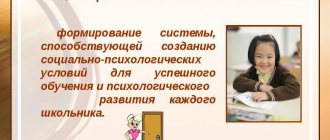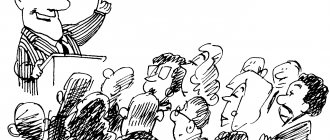Thinking and speech are closely related to each other, however, they cannot be called unequivocally one and the same. It also cannot be said that one stems from the other, but one should not deny the connection between thinking and speech. Speech has its own tools for managing it, called grammar, while thinking operates with logic and logical concepts. Logic and grammar are completely different tools that perform completely different functions. They cannot be equated to each other from any point of view. In addition to the above, it is worth noting that although speech and thinking historically helped each other develop, they still occurred separately and initially performed different functions in human life.
Interrelation of concepts
The psychology of thinking and speech examines these concepts in a complex manner. It is thanks to them that humans differ from animals. Animals think simply, elementarily. They are not distracted from the process of thinking by mediated consciousness. Because of this, they only pay attention to visible objects.
A person uses speech to name an object with a special word. The verbal shell allows you to make a thought material in order to continue its study without visible objects.
Thinking without knowledge of speech is impossible. Moreover, the deeper you think through a thought, the more words you will need to describe it verbally or in writing.
Historical sketch
Researchers involved in the study and development of psychological science do not deny direct connections between speech and thinking, but their opinions regarding their genetic origin differ.
The first scientist who made a major contribution to the study of the relationship between these two concepts was L.S. Vygotsky. He proved that speech and thinking should be studied from the perspective of different roots.
At the same time, linguists contradicted him. They argued that human behavior cannot be linked to its speech.
Another theory that proves the relationship between thinking and speech is the Sapir-Whorf doctrine. Using this concept, researchers have proven that thanks to the structure of language, thinking and different ways of understanding reality are formed.
Classification
Types of speech:
- Monologue, dialogic. Monologue is considered more complex, since a person tells something to others, while no one helps him or suggests. Dialogical - communication between different people. It is considered simpler.
- Descriptive is the most complex type of speech, which is associated with presentation and description.
- Internal, external. Internal speech cannot exist without external speech. Its main functions are regulation and planning. External - oral, loud.
- Written, oral. Written language is considered later and more complex. It can only be learned from other people. Oral is simpler. People learn it on their own.
Types of thinking:
- Visual-figurative. They are used to solve mental problems with the help of visual images and situations from personal experience.
- Visually effective. With its help, an individual solves mental problems by interacting with a specific object.
- Verbal and logical. Mental problems are solved using judgments, concepts, and inferences.
According to the nature of the problems being solved, thinking is divided into two groups:
- Practical - with its help, a person outlines a goal, draws up a plan that is designed to solve a practical problem.
- Theoretical - with its help people solve cognitive problems.
Power is in words
Sometimes a person doesn’t even realize what an extraordinary ability he has. He can talk! Only man can do this, and no other living creature in the world. It is very important to be able to control your speech. Preferably, all its types, of which there are many. Unfortunately, the majority uses only oral communication – through verbal communication.
But there is also a written one. Text speech involves the use of graphics and syntactic structures, compliance with the composite structural organization. To create good, readable text, a person must be a thinker. Because it’s not enough to just write. This must be done in such a way that the reader understands what the author was trying to convey to him. That is why all speakers compose the texts of their speeches. People preparing a speech first write it on paper and then rehearse it.
Characteristics
Thought processes:
- proceed based on an already existing knowledge base;
- associated with the activities of the individual;
- reflect the relationship in verbal form;
- come from living contemplation.
Characteristics of thinking:
- productivity;
- speed, pace;
- focus;
- harmony, which can be logical, grammatical.
Characteristics of speech:
- Voice is a practical means of communicating emerging thoughts to other people. When used correctly, voice skills can be used as a powerful tool to influence others.
- Pace. This concept describes speech speed, the pronunciation of individual words with certain delays. If an individual has professional speech skills, he can easily adjust the pace, depending on what information he is presenting.
- Volume. Depending on the circumstances, the individual changes the volume of his voice. Some words need to be emphasized loudly in order to draw the attention of others to them.
- Voice pitch. With its help, you can convey your psychological state to others. For example, if a person uses a deep voice, they seem much more confident.
- Intonation. With its help, you can interpret the same words differently. Only with the help of intonation can you make an interrogative or exclamatory sentence if there is an oral description.
To build a constructive dialogue with others, you need to be able to influence other people.
Thinking of preschool children
Features of thinking are directly related to age. Preschoolers develop quickly. They are characterized by a rapid expansion of the range of mental tasks. This becomes possible thanks to an effective form of thinking. This is the main type for children.
A child aged 3-6 years is engaged in various activities. It is aimed at enriching existing knowledge about objects and their features. The preschooler learns independence in choosing and solving problems that arise before him. Relevant studies have been carried out regarding this issue. They showed that preschool children tend to shift from practical to mental actions.
Children of primary preschool age (3-4 years old) begin solving the problem immediately. The child does not engage in preliminary analysis of the question posed. He begins to solve it and is usually surprised by the result. That is, he comprehends it only after the task is completed. But children 5-6 years old often vocalize what they are doing. At 6-7 years old, a child is able to complete a task mentally. After that, he says what he plans to do. This happens because speech and thinking are connected. And then he quickly completes the task.
Functions and properties
Modern psychologists distinguish two functions of speech:
- as one of the tools of thinking;
- as a means of communication.
The first function is divided into two subgroups:
- generalization - individual words are related to each other in meaning;
- signaling - with words an individual designates an event or phenomenon.
The second function is divided into 7 subgroups:
- Expressive speech. With its help, a person conveys emotions regarding the words of another person, his own beliefs.
- Communicative - with its help people exchange information.
- Cognitive - it is associated with the study of subjects.
- Expressive - facial expression, facial expressions.
- Primary functions of influence.
- Significative - the individual examines an object and denotes its properties in words.
- Signal is a special function for understanding.
Speech as a tool of thinking, the relationship between thinking and speech. Communication techniques and techniques
Speech as a tool of thinking, the relationship between thinking and speech. Communication techniques and techniques
The main function of human speech is that it is an instrument of thinking. A word as a concept contains much more information than a simple combination of sounds can carry.
The fact that human thinking is inextricably linked with speech is, first of all, proven by psychophysiological studies of the participation of the vocal apparatus in solving mental problems. An electromyographic study of the functioning of the vocal apparatus in connection with mental activity showed that during the most difficult and intense moments of thinking, a person experiences increased activity of the vocal cords. This activity appears in two forms: phasic and tonic. The first is recorded in the form of high-amplitude and irregular bursts of speech motor potentials, and the second - in the form of a gradual increase in the amplitude of the electromyogram. It has been experimentally proven that the phasic form of speech motor potentials is associated with the hidden pronunciation of words to oneself, while the tonic form is associated with a general increase in speech motor activity.
It turned out that all types of human thinking associated with the need to use more or less detailed reasoning are accompanied by an increase in speech motor impulses, and habitual and repeated mental actions are accompanied by its reduction. There appears to be a certain optimal level of variation in the intensity of human speech-motor reactions, at which mental operations are performed most successfully, as quickly and accurately as possible.
RELATIONSHIP OF THINKING AND SPEECH
Throughout the history of psychological research into thinking and speech, the problem of the connection between them has attracted increased attention. Its proposed solutions were very different - from the complete separation of speech and thinking and considering them as completely independent functions from each other to their equally unambiguous and unconditional combination, up to absolute identification.
Many modern scientists adhere to a compromise point of view, believing that although thinking and speech are inextricably linked, they represent relatively independent realities both in genesis and functioning. The main question that is now being discussed in connection with this problem is the question of the nature of the real connection between thinking and speech, their genetic roots and the transformations that they undergo in the process of their separate and joint development.
L.S. Vygotsky made a significant contribution to solving this problem. The word, he wrote, relates to speech as well as to thinking. It is a living cell that contains, in its simplest form, the basic properties inherent in verbal thinking as a whole. A word is not a label pasted as an individual name on a separate object. It always characterizes the object or phenomenon it denotes in a general way and, therefore, acts as an act of thinking.
But the word is also a means of communication, so it is part of speech. Being devoid of meaning, the word no longer refers to either thought or speech; Having acquired its meaning, it immediately becomes an organic part of both. It is in the meaning of the word, says L.S. Vygotsky, that the knot of that unity, which is called verbal thinking, is tied.
However, thinking and speech have different genetic roots. Initially they performed different functions and developed separately. The original function of speech was the communicative function. Speech itself as a means of communication arose due to the need to separate and coordinate the actions of people in the process of joint work. At the same time, in verbal communication, the content conveyed by speech belongs to a certain class of phenomena and, therefore, already presupposes their generalized reflection, i.e. fact of thinking. At the same time, such a method of communication as a pointing gesture, for example, does not carry any generalization and therefore does not relate to thought.
In turn, there are types of thinking that are not associated with speech, for example, visual-effective, or practical, thinking in animals. In small children and in higher animals, unique means of communication are found that are not associated with thinking. These are expressive movements, gestures, facial expressions that reflect the internal states of a living being, but are not a sign or a generalization. In the phylogenesis of thinking and speech, a pre-speech phase in the development of intelligence and a pre-intellectual phase in the development of speech clearly emerges.
L.S. Vygotsky believed that at the age of approximately 2 years, i.e. In what J. Piaget designated as the beginning of the stage of pre-operational thinking following sensorimotor intelligence, a critical turning point occurs in the relationship between thinking and speech: speech begins to become intellectualized, and thinking becomes verbal.
Signs of the onset of this turning point in the development of both functions are the child’s rapid and active expansion of his vocabulary (he often begins to ask adults the question: what is this called?) and an equally rapid, spasmodic increase in his communicative vocabulary. The child, as it were, discovers for the first time the symbolic function of speech and discovers an understanding that behind the word as a means of communication there actually lies a generalization, and uses it both for communication and for solving problems. He begins to call different objects with the same word, and this is direct evidence that the child is mastering concepts. When solving any intellectual problems, he begins to reason out loud, and this, in turn, is a sign that he is using speech as a means of thinking, and not just communication. The meaning of the word as such becomes practically accessible to the child.
But these facts are signs of only the beginning of the real assimilation of concepts and their use in the process of thinking and in speech. Further, this process, deepening, continues for quite a long time, right up to adolescence. The real assimilation of scientific concepts by a child occurs relatively late, approximately at the time to which J. Piaget attributed the stage of formal operations, i.e. to average age from 11-12 to 14-15 years. Consequently, the entire period of development of conceptual thinking takes about 10 years in a person’s life. All these years of intensive mental work and educational activities are spent on the child mastering the most important category for the development of both intelligence and all other mental functions and personality as a whole - the concept.
The child's first word has the same meaning as a whole phrase. What an adult would express in an extended sentence, a child conveys in one word. In the development of the semantic (meaningful) side of speech, the child begins with a whole sentence and only then moves on to the use of frequent semantic units, such as individual words. At the initial and final moments, the development of the semantic and physical (sounding) aspects of speech proceeds in different, as if opposite, ways. The semantic side of speech develops from the whole to the part, while its physical side develops from part to whole, from word to sentence.
Grammar is somewhat ahead of logic in the development of a child’s speech. He masters the conjunctions “because”, “despite”, “since”, “although” in speech earlier than the semantic statements corresponding to them. This means, wrote L.S. Vygotsky, that the movement of semantics and the sound of a word in mastering complex syntactic structures do not coincide in development.
This discrepancy appears even more clearly in the functioning of developed thought: the grammatical and logical content of a sentence are not always identical. Even at the highest level of development of thinking and speech, when a child masters concepts, only a partial fusion occurs.
Inner speech is very important for understanding the relationship of thought to word. Unlike external speech, it has a special syntax and is characterized by fragmentation, fragmentation, and abbreviation. The transformation of external speech into internal speech occurs according to a certain law: in it, first of all, the subject is reduced and the predicate remains with the parts of the sentence related to it.
The main syntactic characteristic of inner speech is predicativity. Its examples are found in the dialogues of people who know each other well, who understand “without words” what is being discussed in their “conversation.” Such people, for example, do not sometimes have any need to exchange words at all, to name the subject of the conversation, to indicate the subject in every sentence or phrase they utter: in most cases it is already well known to them. A person, thinking in an internal dialogue, which is probably carried out through inner speech, seems to communicate with himself. Naturally, he doesn’t even need to identify the subject of the conversation for himself.
The basic law of development of the meanings of words used by a child in communication is their enrichment with vital individual meaning. Functioning and developing in practical thinking and speech, the word seems to absorb new meanings. As a result of this operation, the meaning of the word used is enriched with a variety of cognitive, emotional and other associations. In inner speech - and this is its main distinguishing feature - the predominance of meaning over meaning is brought to its highest point. We can say that internal speech, unlike external speech, has a compressed predicative form and an expanded, deep semantic content.
Another feature of the semantics of inner speech is agglutination, i.e. a kind of merging of words into one with their significant abbreviation. The resulting word seems to be enriched with a double or even triple meaning, taken separately from each of the two or three words combined in it. So, in the limit, you can reach a word that absorbs the meaning of a whole statement, and it becomes, as L.S. Vygotsky said, “a concentrated clot of meaning.” To completely translate this meaning into the plane of external speech, it would probably be necessary to use more than one sentence. Inner speech, apparently, consists of words of this kind, completely different in structure and use from the words that we use in our written and spoken speech. Due to the above-mentioned features, such speech can be considered as an internal plane of speech thinking. Inner speech is the process of thinking with “pure meanings”. A.N. Sokolov showed that in the process of thinking, inner speech is an active articulatory, unconscious process, the unimpeded flow of which is very important for the implementation of those psychological functions in which inner speech takes part. As a result of his experiments with adults, where, in the process of perceiving a text or solving an arithmetic problem, they were asked to simultaneously read out loud well-learned poems or pronounce the same simple syllables (for example, “ba-ba” or “la-la”), it was established that both the perception of texts and the solution of mental problems are seriously hampered in the absence of inner speech. When perceiving texts in this case, only individual words were remembered, and their meaning was not captured. This means that thinking is present during reading and necessarily presupposes the internal, hidden from consciousness, work of the articulatory apparatus, which translates perceived meanings into meanings, of which, in fact, inner speech consists.
Similar experiments conducted with primary schoolchildren turned out to be even more revealing than with adult subjects. For them, even a simple mechanical delay in articulation during mental work (clamping the tongue between the teeth) caused serious difficulties in reading and understanding the text and led to gross errors in writing.
A written text is the most extensive speech utterance, which involves a very long and complex path of mental work to translate meaning into meaning. In practice, this translation, as shown by A.N. Sokolov, is also carried out using an active process hidden from conscious control associated with the work of the articulatory apparatus.
Egocentric speech occupies an intermediate position between external and internal speech. This is speech directed not at a communication partner, but at oneself, not calculated and not implying any feedback from another person present at the moment and located next to the speaker. This speech is especially noticeable in children of middle preschool age when they play and seem to talk to themselves during the game.
Elements of this speech can also be found in an adult who, while solving a complex intellectual problem, thinking out loud, utters some phrases in the process of work that are understandable only to himself, apparently addressed to another, but not implying a mandatory response on his part. Egocentric speech is speech-reflection, serving not so much communication as thinking itself. It acts as external in form and internal in its psychological function. Having its original roots in external dialogical speech, it ultimately develops into internal speech. When difficulties arise in a person’s activities, the activity of his egocentric speech increases.
With the transition of external speech to internal egocentric speech gradually disappears. The decrease in its external manifestations should be viewed, as L.S. Vygotsky believed, as an increasing abstraction of thought from the sound side of speech, which is characteristic of internal speech.
So far we have talked about the development of verbal thinking, i.e. that form of intellectualized speech which, sooner or later, ultimately turns into thought. We are convinced that thinking in its development has its own sources, independent of speech, and follows its own laws for a long period of time, until thought flows into speech, and the latter becomes intellectualized, i.e. understandable. We also know that even at the highest levels of development, speech and thinking do not completely coincide. This means that speech must have its own roots and laws of ontogenetic development. Let's look at some of them.
The experience of studying the process of speech development in children belonging to different peoples, countries, cultures and nations shows that, despite the fact that the differences in the structure and content of modern languages are striking, in general the process of a child’s acquisition of his native speech follows general laws everywhere. For example, children of all countries and peoples with amazing ease acquire language and master speech in childhood, and this process begins and ends for them at approximately the same time, going through the same stages. By the age of about 1 year, all children begin to pronounce individual words. At about 2 years of age, a child already speaks in two or three word sentences. By about 4 years of age, all children are able to speak quite freely.
One-year-old children usually already have quite a rich experience of interacting with the surrounding reality. They have clear ideas about their parents, about the environment, about food, about the toys with which they play. Long before children practically begin to use speech, their figurative world already has ideas that correspond to the words they are learning. In such conditions, prepared by previous experience of socialization, for mastering speech there is not much left for the child to do: mentally connect his existing ideas and images of reality with combinations of sounds corresponding to individual words. By the age of one, these sound combinations themselves are also already well known to the child: after all, he has heard them many times from an adult.
The next stage of speech development occurs at the age of approximately 1.5-2.5 years. At this stage, children learn to combine words, combine them into small phrases (two or three words), and they progress quite quickly from using such phrases to composing entire sentences.
After two or three word phrases, the child moves on to using other parts of speech and constructing sentences in accordance with the rules of grammar. At the previous and current stages of speech development, there are three ways to master language and further improve speech on this basis: imitation of adults and other people around them; the formation of conditioned reflex connections, associative in nature, between images of objects, actions, perceived phenomena and corresponding words or phrases; formulation and testing of hypotheses about the connection between words and images empirically (so-called operant conditioning). To this we should add a kind of childish speech ingenuity, which manifests itself in the fact that the child suddenly, completely independently, on his own initiative, begins to invent new words, pronounce phrases that he has never heard from an adult
TECHNIQUES AND COMMUNICATION METHODS
The content and goals of communication are its relatively unchanged components, depending on human needs, which are not always amenable to conscious control. The same can be said about cash means of communication. This can be learned, but to a much lesser extent than technology and communication techniques. The means of communication is understood as the way in which a person realizes certain contents and goals of communication. They depend on a person’s culture, level of development, upbringing and education. When we talk about the development of a person’s abilities, skills and communication skills, we primarily mean technology and means of communication.
Communication techniques are ways of pre-setting a person to communicate with people, his behavior in the process of communication, and techniques are the preferred means of communication, including verbal and non-verbal.
Before entering into communication with another person, you need to determine your interests, correlate them with the interests of your communication partner, evaluate him as a person, and choose the most appropriate technique and methods of communication. Then, already in the process of communication, it is necessary to control its progress and results, be able to correctly complete the act of communication, leaving the partner with an appropriate, favorable or unfavorable, impression of himself and making sure that in the future he has or does not have (if this desire is not present) ) desire to continue communication.
At the initial stage of communication, his technique includes such elements as the adoption of a certain facial expression, posture, choice of initial words and tone of utterance, movements and gestures, attracting the partner’s attention, actions aimed at pre-setting him for a certain perception of the message being communicated (transmitted information).
Facial expression must correspond to three points: the purpose of the message, the desired result of communication and the demonstrated attitude towards the partner. The posture taken, like facial expression, also serves as a means of demonstrating a certain attitude either to the communication partner or to the content of what is being communicated. Sometimes the subject of communication consciously controls the posture in order to facilitate or, on the contrary, complicate the act of communication. For example, talking with an interlocutor face to face from a close distance facilitates communication and indicates a friendly attitude towards him, and talking while looking to the side, standing half-turned or with his back and at a considerable distance from the interlocutor, usually makes communication difficult and indicates an unfriendly attitude towards him. Let us note that posture and facial expression can be controlled consciously and developed unconsciously and, despite the will and desire of the person himself, demonstrate his attitude to the content of the conversation or the interlocutor.
The choice of initial words and tone that initiate the act of communication also has a certain impression on the partner. For example, a formal tone means that the communication partner is not in the mood to establish friendly personal relationships. The same purpose is served by emphasizing the “you” address to a familiar person. On the contrary, the initial address on “you” and the transition to a friendly, informal tone of communication are a sign of a friendly attitude, the partner’s willingness to establish informal personal relationships. Approximately the same is evidenced by the presence or absence of a friendly smile on the face at the initial moment of communication.
The first gestures that attract the attention of a communication partner, as well as facial expressions (facial expressions), are often involuntary, so communicating people, in order to hide their condition or attitude towards their partner, look away and hide their hands. In these same situations, difficulties often arise in choosing the first words, slips of the tongue, speech errors, and difficulties often occur, the nature of which S. Freud spoke a lot and interestingly about.
In the process of communication, some other types of techniques and conversation techniques are used, based on the use of so-called feedback. In communication, it is understood as the technique and methods of obtaining information about a communication partner, used by interlocutors to correct their own behavior in the communication process.
Feedback includes conscious control of communicative actions, observation of the partner and assessment of his reactions, and subsequent changes in one’s own behavior in accordance with this. Feedback presupposes the ability to see oneself from the outside and correctly judge how a partner perceives himself in communication. Inexperienced interlocutors most often forget about feedback and do not know how to use it.
The feedback mechanism presupposes the partner’s ability to correlate his reactions with assessments of his own actions and draw a conclusion about what caused a certain reaction of the interlocutor to the words spoken. Feedback also includes corrections that the communicating person makes to his own behavior, depending on how he perceives and evaluates the actions of his partner. The ability to use feedback in communication is one of the most important aspects of the communication process and the structure of a person’s communicative abilities.
Communication abilities are the skills and abilities of communicating with people on which one’s success depends. People of different ages, education, culture, different levels of psychological development, having different life and professional experiences, differ from each other in their communication abilities. Educated and cultured people have more pronounced communication abilities than uneducated and uncultured people. The richness and diversity of a person's life experience, as a rule, is positively correlated with the development of his communication abilities. People whose professions require not only frequent and intensive communication, but also the performance of certain roles in communication (actors, doctors, teachers, politicians, managers) often have more developed communication abilities than representatives of other professions.
The techniques and methods of communication used in practice have age-related characteristics. Thus, in children they are different from adults, and preschoolers communicate with surrounding adults and peers differently than older schoolchildren do. The communication techniques and techniques of older people, as a rule, differ from those of young people.
Children are more impulsive and spontaneous in communication; their technique is dominated by non-verbal means. Children have poorly developed feedback, and communication itself is often overly emotional. With age, these features of communication gradually disappear and it becomes more balanced, verbal, rational, and expressively economical. Feedback is also being improved.
Professional communication is manifested at the pre-tuning stage in the choice of tone of expression and in specific reactions to the actions of the communication partner. Actors are characterized by a playful (in the sense of acting) style of communication with others, since they get used to frequently playing different roles and often get used to them, as if continuing the game in real human relationships. Teachers and managers, due to established undemocratic traditions in the field of business and pedagogical communication, are often characterized by an arrogant, mentoring tone. Doctors, especially psychotherapists, usually show increased attention and empathy when communicating with people.
This consultation was prepared by teacher-psychologist MBDOU DS No. 43 “Kolobok” Litvinova S.I. based on the book by R.S. Nemov
psychology
In three books 4th edition
Book 1
GENERAL BASICS OF PSYCHOLOGY
Moscow. 2003
Page 323-324, pp. 519…
Violations
Speech disorders are called aphasia. There are 7 types of disease:
- Efferent motor. The patient loses the ability to combine sounds with each other, which is why he continues to pronounce individual simple syllables.
- Optical-monistic. People suffering from this form of the disease cannot describe actions, images, or objects.
- Semantic. The patient cannot build logical connections between individual words in sentences.
- Dynamic. People with this disease stop speaking phrases and replace them with simple phrases.
- Sensory. The patient hears other people, but does not understand what they are saying.
- Afferent motor. The individual confuses individual sounds in the process of speaking.
- Acoustic-monistic. There are difficulties in writing words and sentences under dictation.
Disorders of thought processes:
- fragmentation, incoherence;
- slow or accelerated formation of thoughts;
- the appearance of obsessive thoughts;
- delirium;
- reassessment of real facts;
- fruitless thoughts, reasoning.
Thinking disorders are caused by somatic and psychological diseases.
Research methods
There are several methods that are used to study speech and thinking:
- observation;
- conversations;
- experiments;
- survey;
- testing;
- software, mathematical modeling of thought processes.
There are several sciences that deal with in-depth study of speech:
- graphology;
- rhetoric;
- psycholinguistics;
- linguistics.
Each of them studies individual manifestations of speech, handwriting, written and oral expression.
Development methods
Thinking and language skills can be developed at any age.
For this, psychologists are creating new methods and exercises, many of which are effective for both adults and children.
Methods for developing speech skills:
- Visual - they allow you to create a rich theoretical basis for the further development of speech. To do this, the individual must travel, visit exhibitions, museums, and theaters.
- Verbal - reading works, memorizing passages of texts, generalizing conversations, retellings.
- Practical - didactic exercises, round dance games, plastic sketches.
People who have poorly developed thinking cannot actively develop creatively, have difficulty describing objects, phenomena, and building logical connections between them.
Groups of exercises for developing thinking:
- Comparative methods. Their goal is for the person to name as many differences as possible between two or more objects.
- Recreation of existing or fantastic images. Using this technique, you can develop your imagination, learn to describe objects, phenomena, and their changes under the influence of external factors.
To develop thinking and speech in children, you need to transform practices into exciting games.
They will help your child not get tired during the learning process, absorb new information with ecstasy, and develop skills.
Thinking and speech are inseparable. Only with the help of speech skills can an individual determine individual properties of objects for their further in-depth study. Impaired thought processes will affect human speech and vice versa. Exercises are used to develop thinking and speech skills.
From thoughts to actions
Surely this phrase is well known to everyone. And it contains the answer to the question mentioned above.
An activity is a human activity that carries a certain meaning. In any case, no matter what it concerns, it is divided into stages. The first step is to set a goal. Motivation is important here. Goal setting and the search for motivation are associated with a process of analysis, during which a person “disassembles” the situation into bricks, after which he designs his actions. Then comes the process of implementing them (how long it lasts depends on the goal) and achieving the result.
A simple example: a person wants to buy an apartment. Let's say for 1,500,000 rubles. The goal is to earn this amount. The motivation lies in the desire to gain property, a personal “roof over one’s head” and a certain independence. Action planning: find a job with a minimum income of 45,000 rubles. Of which 30,000 will be set aside for the purchase of property - then in 50 months (if you follow the plan) the goal will be achieved. When the amount is accumulated and housing is purchased, a person will compare his results with expectations, check whether he met the deadline, etc. This example shows that every action (that is, activity) is associated with thinking - with analysis, reasoning, making calculations, drawing up a plan and drawing some conclusions for yourself.







